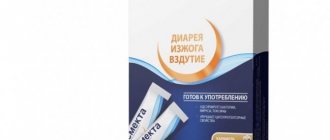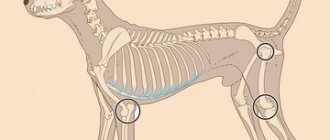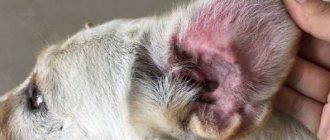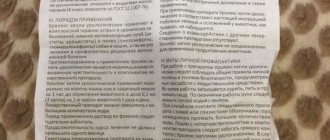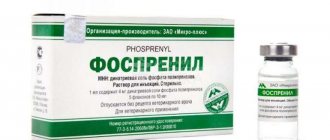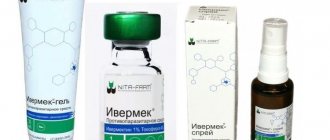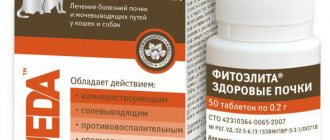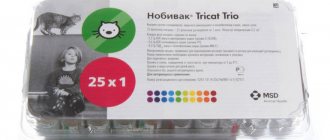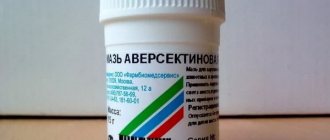Composition and action
The complex drug contains several medicinal components:
- Berberis - dried roots of barberry, in homeopathy they are included in the composition of drugs prescribed for renal and hepatic colic, for acute sudden pain in the liver, bladder and other organs of the urinary system, for pain in the lateral abdomen and kidneys;
- Cantharis (Spanish fly) - is included in the homeopathic preparation to relieve inflammatory processes in the organs of the urinary system. Used in urology for inflammatory diseases of the urethra and bladder, severe inflammation;
- Hepar sulfuris (hepar sulfur) - used to eliminate chronic foci of infection that are resistant to antibiotic therapy;
- Cuprum arsenicosum – copper arsenite, has an antispasmodic effect, helps eliminate colic.
Cantaren has antispasmodic, anti-inflammatory, diuretic effects, activates regenerative processes in the kidneys and urinary tract.
Important!
Cantaren is produced in two dosage forms - tablets and solution for injection. Injections are used more often in the treatment of urological diseases - they provide rapid action and maximum therapeutic effect.
Safety and hygiene measures
When using this drug, you must adhere to generally accepted rules of hygiene, as well as techniques for handling syringes and medications. So, you should wash your hands before and after manipulation.
Important! You should not use the contents of a previously opened ampoule, as the medicine in it may no longer be suitable for use.
If the medicine gets on the skin, it is necessary to wash it off with water to prevent the person from developing allergies. Used ampoules should be discarded.
Purpose
Cantaren is used to treat acute and chronic diseases of the urinary organs in cats. Indications for use are:
- cystitis;
- nephritis;
- pyelonephritis;
- urethritis;
- glorumelonephritis;
- nephrosis.
Cystitis is a common inflammatory disease of the bladder, which can be caused by stagnation of urine or the presence of infection, usually pathogenic bacteria, but sometimes the inflammatory process is provoked by fungi or viruses. Bacterial cystitis is caused by staphylococci, streptococci, Proteus, Enterobacteriaceae, Escherichia and other pathogenic microorganisms. The reasons for the penetration of bacteria into the urinary system can be:
- stagnation of urine;
- damage to the mucous membranes of the bladder or urinary canals, including those caused by urolithiasis (urolithiasis);
- injuries;
- tumors;
- stress.
With cystitis, a cat experiences frequent and painful urination: the cat meows, sits down not only in the tray, but also in other unsuitable places, the presence of blood in the urine (you may notice a change in the color of the urine - from pink to deep red, or blood clots). After each urination (or attempt), the cat actively licks itself, which also indicates the presence of pain.
Cystitis can be acute or chronic. The latter may have no visible symptoms. During an ultrasound examination, thickening of the walls of the bladder can be observed, due to which it does not empty completely. In stagnant urine, pathogenic bacteria actively develop, which cause an exacerbation of the pathology. Periodic inflammatory processes reduce the cat's immunity.
The consequence of chronic cystitis can be the development of renal pathologies. Pyelonephritis is an inflammation of the renal pelvis that develops under the influence of pathogenic bacteria. The pathology can threaten the life of the animal: without treatment, kidney failure develops: toxic substances are not bound and removed from the body, which can lead to death.
According to the degree of development, pyelonephritis can be primary, when it develops directly in the kidneys, and secondary, when the disease becomes a consequence of infection of other organs of the urinary system. Acute inflammation of the renal pelvis can be suspected when the cat is febrile, lethargic, or lacks a response to various stimuli. The pet feels pain in the abdomen and kidneys (does not allow him to touch the body), the amount of urine produced decreases, it acquires an unpleasant odor, and blood and purulent discharge may be observed.
There are catarrhal, hemorrhagic and purulent pyelonephritis. The latter is the most dangerous because it can cause uremia - acute poisoning of the body with poisons formed during the breakdown of proteins: ammonia, urea, cyanate, acetone, etc. Signs of advanced pathology are:
- refusal of food;
- smell of ammonia from the mouth;
- apathy;
- increased thirst;
- decreased body temperature (below 37 degrees);
- convulsions and others.
Without treatment, the disease leads to uremic coma and death of the animal. Therefore, it is important to contact a veterinarian at the first sign of kidney disease.
Urethritis is an inflammatory disease affecting the urethra. The reasons may be improper feeding, which leads to urolithiasis and, as a result, urethritis, damage to the urethra. If a pet cannot go to the litter box, urine stagnates and toxins accumulate in the body, which lead to intoxication and death.
Important!
The main cause of urolithiasis - urolithiasis, which without treatment can cause premature death of the animal - is improper feeding.
Cheap food and human food containing salt can cause urolithiasis, a chronic disease in which salt deposits, sand, and stones form in the bladder. Veterinarians consider other reasons to be viral and infectious diseases, a sedentary lifestyle, genetic predisposition, and stress. The pathology is accompanied by painful urination, frequent urge to urinate, and the presence of blood in the urine. In severe cases, the urethra may become blocked by stones.
When to use the medicine
The wide spectrum of action allows the drug to be used for various pathologies of the genitourinary system in pets.
- Urethritis in any form - chronic, as well as exacerbation of the condition;
- Pyelonephritis, pyelitis;
- Accumulation of sand and stones in the urinary tract;
- Cystitis, vaginitis;
- Bladder tonesmus;
- Renal colic;
- Urological syndromes;
- Infectious diseases of the genitourinary system.
In addition to the properties described above, Cantaren allows you to normalize protein metabolism in the cat’s body. Therefore, it is important to use the drug in cases of water-salt imbalance.
Veterinarians advise not to wait until the genitourinary system develops symptoms of the disease. Cantaren can be used as a prophylactic agent. It would also be a good idea to keep the medicine in the first aid kit. Cantaren can be used as an emergency treatment for a domestic cat even before the veterinarian arrives.
Cantaren can also be used one-time if the owner does not know what diagnosis awaits the cat, but sees obvious symptoms. For example, blood clots in the urine of an animal. You can also give Kantaren to your animal if it experiences pain when urinating.
After such a one-time dose, you should definitely contact a veterinarian for examination. Long-term treatment with Cantaren should not be carried out without consulting a doctor. The drug is used to relieve symptoms until a diagnosis is made. The cat should be examined by a specialist!
If the condition worsens, it is recommended to use an injectable form of the medicine before the doctor arrives.
Dosage
For cats, it is more convenient to use an injection solution. Injections can be given intramuscularly or subcutaneously. Kittens and adult cats are given 0.2-2 ml of Cantaren solution 1-3 times a day. For acute inflammations, the course of treatment is 7-10 days, for the treatment of chronic pathologies - 1 injection per day for 3-4 weeks.
Injections are placed under the skin in the withers area. You need to pull back the fold, carefully pierce the skin, inserting the syringe needle at an angle of 45 degrees, then slowly inject the medicine.
Intramuscular injections are made into the thigh area. It is better to choose syringes with thin needles, insert the needle approximately 1-1.5 cm and quickly inject the medicine.
Important!
If the doctor has prescribed a course of injections, they should be done at the same time, this improves the therapeutic effect.
Dosage of the drug
For pathologies of the genitourinary system, the dosage of medication for cats should be determined by a veterinarian. The specialist creates a treatment regimen based on the age of the animal and the nature of the disease.
But in case of emergency use of the drug, the owner is advised not to wait for the veterinarian’s recommendation and use the following dosage. There should be 1 ml of substance per kilogram of animal body weight. So, a cat weighing 4 kg should receive a subcutaneous injection in the amount of 4 ml of medicine. But at one time you need to administer 0.5-1.5 ml of the drug, so a dose greater than this figure must be divided into several injections during the day.
For preventive purposes, it is recommended to use Cantaren in tablet form. The course lasts two weeks and follows the following scheme: one to two tablets per day. In case of exacerbation of chronic diseases or relapse, the dose is increased to two tablets twice a day.
Composition of the medicine
Regardless of the form in which the medicine was purchased, it always contains four main substances that have an active effect:
- Sulfur liver. It has a powerful antibacterial effect, helps destroy all pathogenic microorganisms and viruses.
- Barberry. Tones the animal's urinary tract. Helps get rid of accumulated salts, stones and sand. Veterinarians, by the way, claim that Cantaren effectively fights liver and kidney pathologies.
- Arsenic copper. It relieves the animal of pain, reduces unpleasant spasms, and also cleanses the genitourinary system and the entire body.
- Spanish front sight. This component significantly improves the removal of salts from the genitourinary system of dogs and cats. The main effect of this substance is that smooth muscles relax.
In addition to all the above components, the medicine also contains other substances. If the tablet form was chosen to treat your pet, then natural sugar cereals, as well as potassium stearate, can be used as an excipient.
But for injections, a multifunctional saline solution containing cantharidin is used. The instructions for use indicate that this particular inhibitor helps to relax the smooth muscles of the urinary tract, promoting a gentler removal of stones.
It is also worth considering that excipients can be presented in the form of filtered water for injection, sodium chlorine. Cantarene contains universal alkaloids: berberubine, palmitine, berebrine, iatroricin, berbamine, ricin. Do not forget about the presence of extracts of medicinal plants, tannins and other natural ingredients. All of them, even before the development of the pharmacological industry, were widely used to treat dangerous diseases in animals.
Instructions for use
Any tablets, including Kantaren, can be given to your pet only in crushed form or mixed into food. When a veterinarian has prescribed a minimum dosage for the treatment of young cats and dogs, they can be given a whole tablet, but only once a day. An adult animal should take 2 to 3 tablets per day. If the disease is severe and has painful symptoms, then the daily dosage can be increased to 4 tablets.
In addition, veterinarians say that an effective treatment method can be used for adult pets when the dosage of the medication is increased gradually. If the pathology is at an early stage and does not cause much discomfort, then therapy should be carried out in a minimal dosage. The course of treatment in this case should not exceed three weeks. An acute disease is treated for at least 5 days, but with a large dosage of medication.
As for preventive measures, they should be carried out no more than once a year, lasting 2 weeks. The animal should take only 1 tablet per day.
Cantaren
Kantaren injections and tablets for the prevention and treatment of kidney and urinary tract diseases accompanied by urological syndrome in cats, dogs and fur-bearing animals
(Developer organization: AlexAnn LLC, Moscow region)
I. General information Trade name of the medicinal product: Cantaren®. International nonproprietary name: not assigned.
Dosage form: solution for injection and tablets for oral use. Cantarene solution for injection contains matrix tinctures of plant, organic origin and mineral components (per 1000 ml) as active ingredients:
- Berberis vulgaris Ø=D1 0.03 ml;
- Lytta vesicatoria Ø=D1 0.3 µl;
- Hepar sulfuris D4 0.2 mg;
- Cuprum arsenicosum D6 0.02 µl;
and excipients: methyl parahydroxybenzoate - 0.5 g, sodium chloride - 5.8 g, sodium acetate trihydrate - 2.0 g, hydrochloric acid to pH 5.4, ethyl alcohol 95% - 5.26 g, water for injection up to 1000 ml. In appearance, the drug is a colorless transparent liquid.
Kantaren tablets contain matrix tinctures of plant, organic origin and mineral components as active ingredients (per 100 g tablets):
- Berberis vulgaris Ø=D1 0.06 ml;
- Lytta vesicatoria Ø=D1 0.6 µl;
- Hepar sulfuris D4 Trituration 0.4 g;
- Cuprum arsenicosum D6 0.04 µl;
and excipients: maltodextrin - 17.5 g, calcium stearate - 1.0 g and sugar granules - up to 100 g. In appearance, they are round, flat, white tablets, weighing 0.1 g.
Kantaren is produced packaged in 10 and 100 ml glass bottles, sealed with rubber stoppers and aluminum roll-up caps, and 50 and 100 tablets in polymer jars, sealed with polymer caps. Bottles of 10 ml and jars of tablets are individually packaged in individual cardboard boxes. Each packaging unit is accompanied by instructions for use.
Kantaren is stored in the manufacturer's sealed packaging, separate from food and feed, in a dry place, protected from direct sunlight, at a temperature of 0 to 25°C. The shelf life of the drug for injection, subject to storage conditions in the manufacturer's closed packaging, is 3 years from the date of production, after the first opening of the bottle - 21 days. The shelf life of Cantaren tablets, subject to storage conditions in a closed package, is 5 years from the date of production, after opening the package - until the expiration date.
Cantarene should not be used after the expiration date. Cantaren should be stored out of the reach of children. Unused medicinal product is disposed of in accordance with legal requirements.
II. Pharmacological properties Kantaren refers to combined homeopathic medicines. It has saluretic (promotes the removal of stones), anti-inflammatory, antispasmodic and diuretic effects, activates reparative processes in the kidneys and urinary tract.
In terms of the degree of impact on the body, the drug is classified as a low-hazard substance (hazard class 4 according to GOST 12.1.007-76), and does not have a local irritant or sensitizing effect.
III. Directions for use Cantaren is prescribed to cats, dogs, and fur-bearing animals for the prevention and treatment of kidney and urinary tract diseases accompanied by urological syndrome, including urolithiasis, cystitis and urethritis.
A contraindication to the use of Cantaren is the individual hypersensitivity of the animal to its components.
Cantaren injections are used intramuscularly or subcutaneously:
- for the purpose of disease prevention, once a day, in courses of 14 days, twice a year;
- in the acute course of the disease 1-2 times a day for 5-10 days;
- for subacute and chronic disease, 2-3 times a week.
The duration of the course of treatment is determined by the veterinarian, but it should not exceed 30 days. A single dose of the drug per animal is 0.1 ml/1 kg of animal weight.
Kantaren tablets are administered to animals orally with a small amount of food or forcefully on the root of the tongue in the following single doses:
- cats and ferrets - 1 tablet per animal,
- dogs - 1 tablet per 10 kg of animal weight.
For prophylactic purposes and to prevent relapses of the disease, tablets are used twice a day for 3 weeks, for therapeutic purposes - two to three times a day for 1-2 weeks.
Symptoms of drug overdose in animals have not been established. The specific effects of the drug upon its first use and withdrawal have not been established.
Omissions should be avoided when administering the next dose of the drug, as this may lead to a decrease in therapeutic and prophylactic effectiveness. If one dose is missed, the use of the drug should be resumed as soon as possible at the same dose and according to the same regimen.
When using Cantaren in accordance with these instructions, side effects and complications are usually not observed. If the animal's individual sensitivity to the components of the drug increases and allergic reactions occur, the use of the drug is stopped and the animal is prescribed antihistamines and symptomatic therapy.
The use of Cantaren does not exclude the use of other drugs for etiotropic, pathogenetic and symptomatic therapy.
The drug is not intended for use in productive animals.
IV. Personal preventive measures When working with Cantaren, you should follow the general rules of personal hygiene and safety precautions provided for when working with medications. After handling the medicine, you should wash your hands with soap. In case of accidental contact of the drug with the skin or mucous membranes of the eyes, they must be rinsed with plenty of water. People with hypersensitivity to the components of Cantaren should avoid direct contact with the drug. In case of allergic reactions or accidental exposure of the drug to the human body, you should immediately contact a medical facility (bring with you the instructions for use of the drug or the label).
Empty drug bottles must not be used for household purposes; they must be disposed of with household waste.
Indications for use of Cantaren
The product has an analgesic, antispasmodic and antibacterial effect, in addition, it quickly cleanses the urinary tract. That is why the medication is prescribed for the following pathologies:
- urethritis;
- cystitis;
- inflammation of the genital organs in cats (vaginitis);
- urolithiasis;
- urolithiasis;
- kidney diseases (for example, pyelonephritis).
Please note that this drug can also be taken by castrated animals. The drug is prescribed for the following symptoms:
The drug is prescribed for the following symptoms:
- pain when urinating in a cat;
- urinary retention;
- the presence of blood in the urine;
- increased body temperature, which indicates an acute inflammatory process;
- with urolithiasis, a cat may urinate not in its intended place, but where the urge to urinate occurs;
- The inflammatory process causes the urine to become cloudy and have a strong, unpleasant odor.
As you can see, the product has a fairly wide range of applications, so every cat owner is recommended to keep it in their home medicine cabinet. However, such a medication must be prescribed by a professional veterinarian.
User reviews
Positive reviews from cat owners and veterinarians confirm the effectiveness of Cantaren for cats. Experts recommend the drug to normalize the acid-salt level in the urine, improve the condition of purring and in the fight against urolithiasis. It is also advisable to use the drug every year for preventive purposes.
Angelina
My cat developed urolithiasis at the age of 6. After successful treatment, the veterinarian recommended the drug Cantaren for prevention. Every year I give him the medicine for 14-15 days. Additionally, I drip Kotervin into my mouth. Thanks to this therapy, the cat is no longer bothered by the disease, he copes well with going to the toilet and eats a lot.
Valeria, owner of the Siamese cattery
As an experienced breeder, I have encountered kidney stones in cats more than once. Thanks to the use of Cantaren, which is prescribed to us by a veterinarian, I manage to nurse my pets. At the first manifestations of symptoms of urolithiasis, I give Cantaren for therapy. Treats quickly and effectively. I would like to note that in severe forms of the disease it is better to administer the drug subcutaneously.
Andrey, Maine Coon owner
My hero was given to me for my birthday. Unfortunately, the pet ended up with health problems. Chronic pyelonephritis was combined with frequent diarrhea and pancreatitis. The kitten could not urinate for 2 days. Noticing the problem, I took the cat to the clinic, where a specialist administered a course of Cantaren therapy. Soon the kitten began to visit the toilet more often, the urine stopped smelling foul, and its color returned to normal.
Given the high effectiveness of Cantaren, most veterinarians use it in their practice to treat a variety of diseases. It is extremely important to carry out annual prophylaxis after treatment.
Contraindications and side effects
Cantaren, like many homeopathic medicines, is characterized by high safety. There are no contraindications to its use, with the exception of the dog’s individual intolerance to Cantaren. It can be used in older dogs, puppies and pregnant women.
The cost of the drug depends on the volume of the package and the form of release.
No side effects were found during the entire period of use.
Therapeutic effect
Homeopathic remedies used in veterinary practice are based on natural ingredients. They can be used without fear of harming the pet, and the medications provide quick, effective help.
Thanks to microdoses of the active substance, Kantaren is safe even for puppies, pregnant and lactating females. However, only a veterinarian can determine the possibility of treating a disease with homeopathic medicines after examining the dog and making a diagnosis.
Cantaren is prescribed for the treatment of:
- urethritis;
- cystitis;
- pyelonephritis;
- urolithiasis.
The medicine is effective as part of complex therapy and is used together with antispasmodics and anti-inflammatory drugs.
The treatment regimen is determined by the doctor, taking into account the symptoms of the disease, the general health of the dog, the results of tests and other clinical studies, and the presence of complications. For acute pathologies, injections are usually used; for long-term treatment, it is better to choose drops and tablets.
The solution is administered intramuscularly, twice a day, 1 ml. The usual course of treatment is 35 days, but depends on the condition of the animal and is determined by the doctor. With frequent relapses of the disease, treatment will be longer - 2-3 weeks or more.
More detailed information about the treatment of dogs with Cantaren and dosages is presented in the table:
Indications for use
Cantaren is prescribed for inflammatory processes of the urinary tract and kidneys: cystitis, urethritis, urolithiasis (KD), nephritis, the presence of kidney stones, etc. In case of breed predilection of animals, after castration, for preventive purposes.
If we compare dogs and cats, diseases of the genitourinary system, in particular urolithiasis, are more common in cats. Dogs are brought in with pronounced symptoms of the disease or are accidentally discovered when taking blood for analysis.
This is explained simply - in cats, the urethra is much narrower than in dogs, so even the smallest urethra can lead to its blockage and clinical signs of the disease immediately appear. Dogs can accumulate dozens of stones, but the owner may not even be aware of the severity of the disease. Kidney stones in dogs form extremely rarely, mainly in the bladder.
Therefore, timely prevention of the animal is so important - regular blood tests and the use of Cantaren. Pets at risk:
